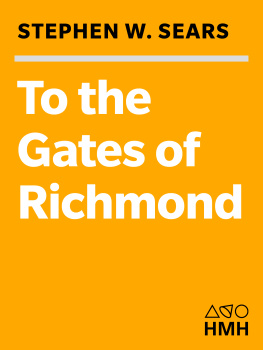This book was published with the assistance of the Fred W. Morrison
Fund for Southern Studies of the University of North Carolina Press.
2012 The University of North Carolina Press
All rights reserved
Manufactured in the United States of America
Set in Arnhem and The Serif types
by Rebecca Evans
The paper in this book meets the guidelines for permanence and durability of the Committee on Production Guidelines for Book Longevity of the Council on Library Resources.
The University of North Carolina Press has been a member of the Green Press Initiative since 2003.
Library of Congress Cataloging-in-Publication Data to come
Brasher, Glenn David.
The Peninsula Campaign and the necessity of emancipation: African Americans and the fight for freedom/Glenn David Brasher.1st ed.
p. cm.(Civil War America)
Includes bibliographical references and index.
ISBN 978-0-8078-3544-9 (cloth : alk. paper)
ISBN 978-1-4696-1750-3 (pbk. : alk. paper)
1. Peninsular Campaign, 1862. 2. United StatesHistoryCivil War, 18611865Participation, African American. 3. SlavesEmancipationUnited States. I. Title.
E473.6.B73 2012 973.7'415dc23 2011036321
16 15 14 13 12 5 4 3 2 1
Illustrations and Maps
Illustrations
The Seat of War in Southeastern Virginia /
Slaves at Follers House, Cumberland Landing, Virginia /
Bridge and main entrance to Fort Monroe /
The (Fort) Monroe Doctrine /
Stampede of Slaves /
Ruins of Hampton /
Morning Mustering of the Contrabands /
Allens farmhouse, near Yorktown, Virginia /
Confederate fortifications at Yorktown /
Southern Chivalry /
Union troops examine portions of the abandoned Confederate works at Yorktown /
Intelligent Contraband /
The Reliable Contraband /
A View in Williamsburg, Va. /
Union soldiers and slaves interact at Follers farm /
Group of contrabands at Allens farmhouse /
Richard Slaughter /
Supply vessels at anchor, White House, Virginia, 1862 /
Allan Pinkerton and staff converse with an African American man /
A Consistent Negrophobist /
Harrisons Landing during the Union occupation /
Westover House /
Maps
The Army of the Potomacs advance on Richmond /
The Seven Days Battles /
Introduction
An Evening on Malvern Hill
On July 1, 2001, 139 years after the Battle of Malvern Hill, I stood before a small crowd that had gathered to tour the site. It was my seventh year as a seasonal park ranger for the Richmond National Battlefield Park, and I had spent untold hours walking the ground and researching the fighting. I was capable of providing the visitors with what most came for: descriptions of troop movements, anecdotal stories of bravery, and heartrending tales of sacrifice. However, I planned to offer more than the standard battlefield tour.
Weeks earlier, the parks supervisory ranger, Michael J. Andrus, had asked me to lead the anniversary tour. He had suggested that I discuss the battle as more than just the climactic engagement of the 1862 Peninsula Campaign. He knew that I had researched the connections between Virginia slavery and the Richmond battles, and he wanted the tour to include more content than just guns and glory. Andrus hoped visitors would leave with a better understanding of why Northerners and Southerners slaughtered each other on that field in such horrific numbers and how the battles around Richmond had affected the institution of slavery.
I knew what Andrus was looking for, and why. In the early 1990s, the National Park Service had received much criticism for doing little more at its battlefields than explaining who shot whom and where. Understanding that many adult Americans receive much of their continuing education at the national parks, a 1998 meeting of park superintendents resolved to expand historic interpretation at Civil War battlefield sites. The agency also asked teams of professional historians to evaluate these sites and make recommendations. Richmond National Battlefield Park was one of many locations the scholars criticized for having embarrassingly outdated exhibits that failed to offer visitors a broader understanding of the Civil War. The Park Service accepted these assessments, and soon many battlefield sites began the process of overhauling their interpretations. Richmond National Battlefield Park eventually opened a state-of-the-art visitors center at the site of the historic Tredegar Iron Works, and it impressively adhered to the Park Services new goals.
Nevertheless, for many observers the changes were not occurring rapidly enough, and they correctly pointed out that the Park Services battlefield interpretations still did not reflect the centrality of slavery to the
This directive created considerable controversy, but even as a white Alabamian I could appreciate Congresss action. I always found it disturbing that although the Civil War was a crucial event in African American history, very few blacks ever visited the battlefields. When encountering the infrequent black visitor, I often asked about this apparent indifference to Civil War history among the African American community. The answer was usually the samedespite movies such as Glory, much of Civil War popular culture tended to glorify the Confederacy and largely ignored any African American role in the war.
Thus, the National Park Service has hardly been alone in lagging behind in its interpretations of the Civil War, and the Peninsula Campaign in particular has suffered from relative neglect. Although hundreds of works have been written about the Battle of Gettysburg, the events from April to July 1862 have received far less attention. For years, four books dominated the subject, only two of which took the Peninsula Campaign as the central topic. Furthermore, three of the books presented the event only from the Confederate perspective. Not until 1992, with the publication of Stephen Searss To the Gates of Richmond, was there a truly comprehensive study of the campaign.
Drawing on knowledge gleaned from such sources, however, I was able to craft a tour that met my supervisors expectations. After greeting the visitors, I explained that in the spring of 1862 the Army of the Potomac, under the command of General George B. McClellan, had slowly advanced up the Virginia Peninsula toward Richmond. Arriving just outside the city, it outnumbered the southern army defending the Confederate capital. Yet during a week of almost continuous fighting initiated by General Robert E. Lee, the Confederates used bold and aggressive attacks to drive the northern army away from the city and south toward the James River. Before it could reach the safety of Union gunboats, however, the Army of the Potomac had to fend off one last Rebel attack. Pointing to the high ground on Malvern Hill, I explained to my audience how it provided the Federals with an exceptionally strong defensive position.
Having described the military situation that existed on July 1, 1862, I expanded the focus of the tour by explaining the political context. As the Peninsula Campaign was reaching its climax, Northerners were sharply divided over the issue of emancipation, and General McClellan insisted that the war could be won without resorting to such a radical measure. With his army just outside of the capital of the Confederacy, it appeared that he might be correct. Therefore, I informed the group, the outcome of the Seven Days Battles would likely determine the fate of the institution of slavery. As I ventured into this discussion, I noticed some members of my audience becoming visibly disturbed. Not surprisingly, I saw no black faces in the crowd.







